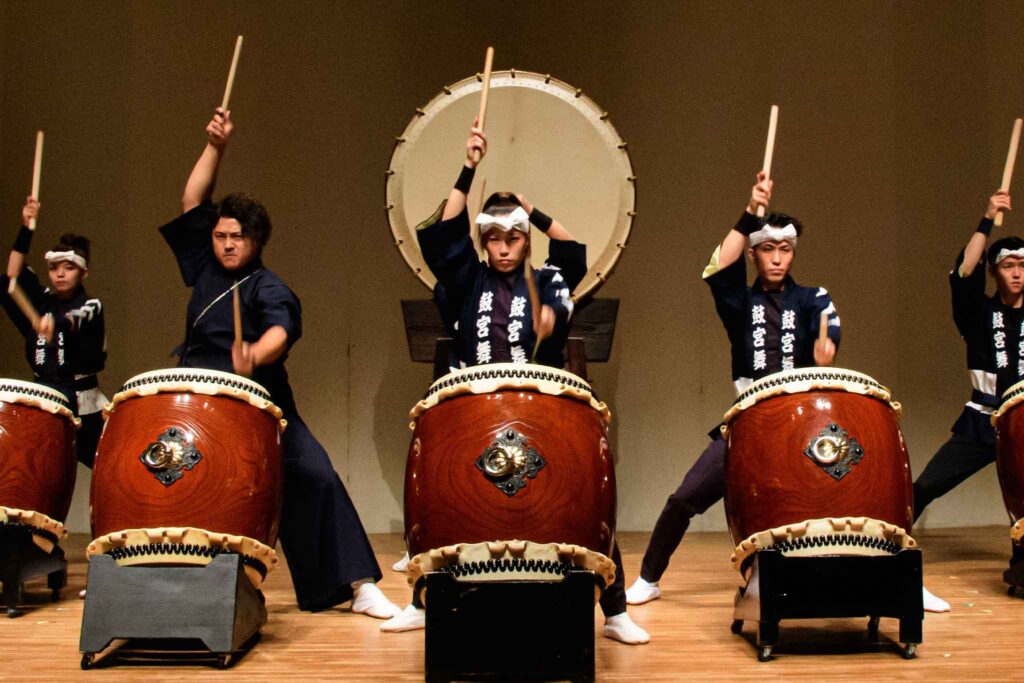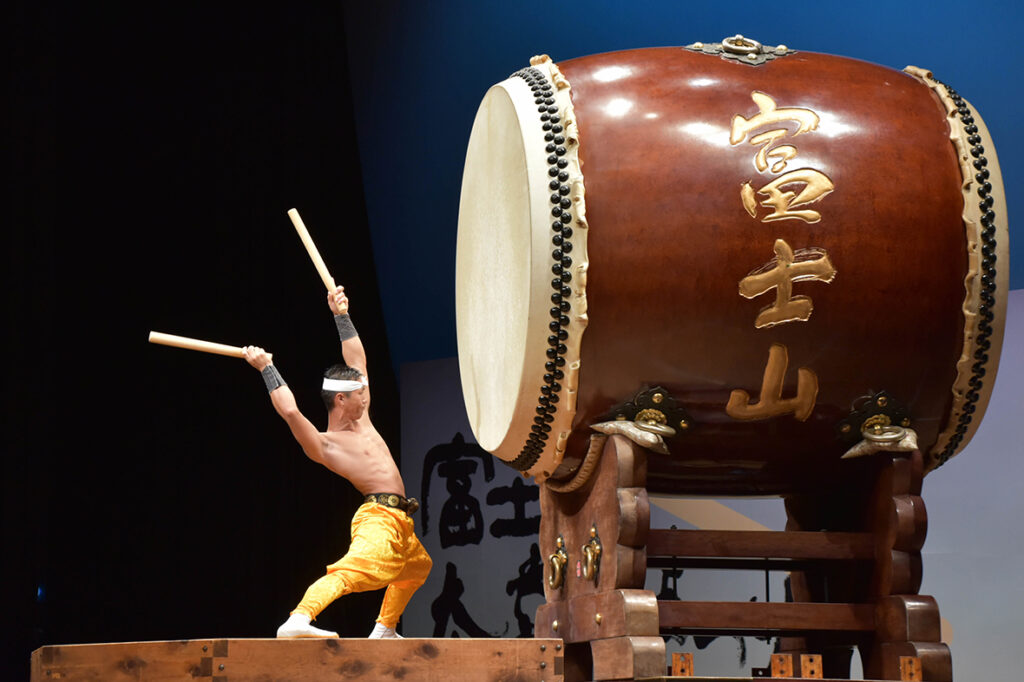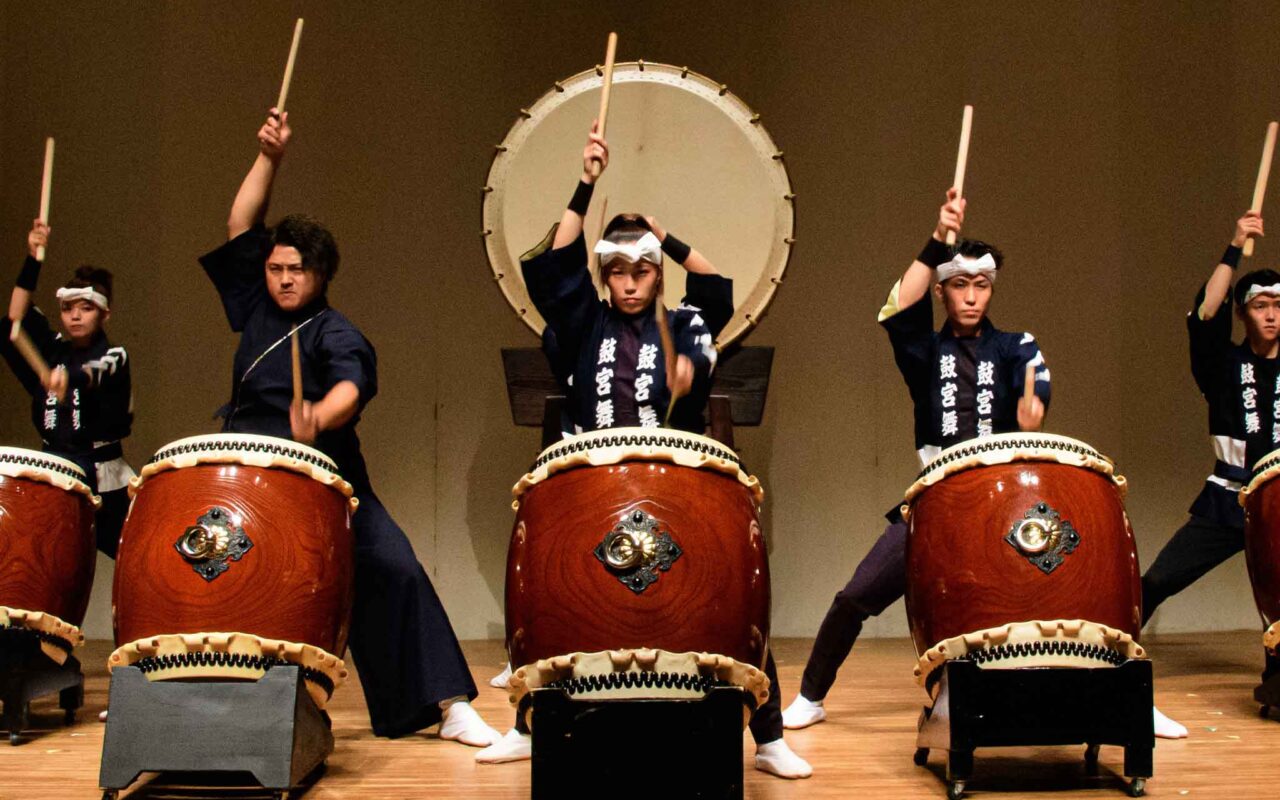Chapter 1: Introduction to Japanese drums
“I think there are many people who don’t know about the Japanese drum, which is an important part of Japanese culture, so I would like to introduce it to you.”The Japanese drum is known for its powerful sound, graceful shape, and rich tone. More than just a musical instrument, it is an important cultural symbol that expresses Japan’s mysterious natural and historical background, as well as community unity. Japanese drums have played a central role in traditional Japanese festivals and events, and have touched the hearts of the Japanese people.
Japanese drums create a sacred atmosphere in sacred places and important ceremonies with their unique deep sound and resonance. In addition, the sound of Japanese drums, due to its power and depth, moves the hearts of Japanese people and has the effect of increasing group cohesion. Japanese drums come in a variety of sizes and shapes, each with different tones and playing methods. Large drums can play deep bass sounds, and small drums can play high sounds, and when they are combined, rich music is created.
A Japanese drum performance is more than just a musical performance; by using the whole body to beat the drum, an exchange of energy is created between the performer and the audience. Japanese drum performances range from powerful and intense to graceful and quiet, giving the audience a variety of emotions. Japanese drum performance is deeply connected to Japan’s nature, history, and people’s lives, and its sound is in perfect harmony with Japan’s climate.
Wadaiko can also be combined with various art forms such as Japanese music, dance, and theater, thereby creating new works of art. The powerful beat and rhythm of Japanese drums make traditional Japanese art even more appealing and can deeply move audiences. Japanese drum performances are an important element in shaping Japan’s culture, history, and people’s hearts, and can be said to be an essential part of experiencing Japan’s beautiful culture.

Quote (https://odekake.de/kokubu/)
Chapter 2: Historical and cultural background
“We will tell you how Japanese drums have developed in Japan up until now, including history and culture.” Japanese drums have been closely related to Japanese society since ancient times, and have a very long history. It becomes. With records of their use in festivals and ceremonies at ancient shrines and temples, Japanese drums have played an important role in the development of Japanese history and culture.
The origins of Japanese drums can be traced back to ancient China, the Korean peninsula, and even South Asia, and it is said that the drums that were introduced from these regions developed into Japan in a unique form. During the Heian and Kamakura periods, it became popular for use in court music and religious ceremonies, and during the Sengoku period, it was used for signals and encouragement on the battlefield. In the Edo period, Japanese drums became popular as a form of entertainment for the common people and became popular with many people.
The performance style and decoration of Japanese drums have changed over time, and each region has its own unique characteristics. The natural environment, history, and culture of each region have influenced the shape, sound, and performance style of Japanese drums, and a diverse Japanese drum culture has been nurtured. For example, Hokkaido’s taiko drums are characterized by their powerful and loud sounds, while Kyushu’s taiko drums are characterized by their delicate sounds and complex rhythms, reflecting regional characteristics.
Japanese drums are deeply rooted in Japan’s history, culture, and people’s lives, and their sounds resonate in the hearts of Japanese people. Japanese drums have brought strength, courage, and community unity to people at festivals, events, and in everyday life. Additionally, the Japanese drum is a beautiful instrument that expresses Japan’s nature, the changing seasons, and the Japanese sensibilities, and is an important medium for conveying Japanese culture and history.
Performing Japanese drums requires a deep understanding of Japanese history and culture, and performers express Japan’s beautiful climate and traditions through the drums. The sound of Japanese drums gives a sense of Japan’s historical background and cultural value, allowing the audience to experience the beautiful culture of Japan. Japanese drums have become a bridge between Japanese tradition and modernity, and are still loved by many people.

Quote (https://gotemba.jp/post-895/)
Chapter 3: Japanese drums in modern times
“Let me introduce you to what Japanese drums are like in modern Japan.” Japanese drums have become an important means of transmitting Japan’s traditional music and culture to the current generation. Its deep resonant sound and powerful performances are loved by many people both in Japan and abroad, and Wadaiko performances are attracting attention on the international stage as a symbol of Japanese culture.
In recent years, new musical styles and performance methods that incorporate Japanese drums have been born, and while preserving ancient traditions, Japanese drums continue to evolve and integrate with new cultures. For example, Japanese drums are creating new expressions through collaboration with various artistic fields, such as performances that combine Japanese drums and electronic music, and contemporary dance performances using Japanese drums.
Japanese drums are also used to promote unity in local communities. Wadaiko performances are often held at local festivals and events, allowing people to feel connected to the community and to Japanese tradition through the sound of wadaiko. Japanese drums bring joy and pride to people in local communities, increasing the strength of the community.
Japanese drumming classes and workshops are also popular, and by learning Japanese drumming, many people, from children to adults, experience the joy of experiencing traditional Japanese culture and learning new skills. Through Japanese drumming, people learn to collaborate and collaborate in groups, express themselves, and experience growth as individuals and as a community.
In modern Japan, Japanese drums are loved by many people as a beautiful art that combines tradition and innovation. Its charm extends beyond Japan’s borders, and it plays an important role in conveying Japan’s beautiful culture and history to people all over the world. Japanese drums continue to be a valuable cultural heritage that connects Japan’s traditional values with modern life.
Chapter 4: Famous works featuring Japanese drums
“Here are some of the famous works that feature Japanese drums.” Japanese drums attract many people with their powerful and soothing sounds, and are featured in many works of art and in the world of entertainment. In movies, music, performing arts, and many other media works, Japanese drums are an important symbol of Japanese tradition and culture.
In the world of movies, Japanese drum performances emphasize Japan’s landscapes and historical background, enriching the story. For example, in many historical dramas and historical dramas, the sound of Japanese drums enlivens war preparations and festival scenes. The powerful sound of Japanese drums moves the audience and enhances the atmosphere of the movie.
In the world of music, concerts and albums featuring Japanese drums have been produced, and Japanese drum performers and groups are highly acclaimed both domestically and internationally. For example, the Japanese drumming group Kodo is internationally known, and their performances widely convey the beauty and power of Japanese drumming. Crossover works that combine Japanese drums with other instruments and musical styles are also popular, creating new musical expressions.
Japanese drums also play an important role in the world of performing arts. In traditional Japanese dance and modern dance performances, the sound of Japanese drums harmonizes with the dance movements, leaving a strong impression on the audience. The sounds of Japanese drums, along with the movements of the artists on stage, provide a fascinating visual and auditory experience.
The sound of Japanese drums is also used in media works, especially advertisements, television programs, and anime, as an effective means of expressing Japanese culture and emotion. The sound of Japanese drums, combined with visual images, strengthens the message of the piece and leaves a deep impression on the viewer.
Through these famous works, Japanese drums are loved and respected by many people as an important element of Japan’s beautiful culture and art. The rich sound of Japanese drums and the beauty of their performance symbolize Japan’s tradition and beautiful culture in many works, and convey the charm of Japanese drums to people all over the world.
Chapter 5: Summary
“Summary about Japanese drums.” Japanese drums are traditional musical instruments that are deeply rooted in Japanese culture and history, and their appeal is widely recognized both in Japan and abroad. The powerful sound and rich tones of Japanese drums have long been loved by people as a unique way to express Japan’s nature, history, and people’s emotions.
The history of Japanese drums reflects the development of Japanese history and culture, and has provided excitement and joy to many people throughout the ages. This traditional musical instrument plays an important role in Japanese festivals and ceremonies, as well as in the world of art and entertainment, and is still loved by many as a way to express Japan’s beautiful culture and history. .
Even today, Japanese drums symbolize Japanese tradition in many media works such as music, theater, and movies, and play a role in introducing Japanese culture to the world. With its unique sound and performance techniques, Japanese drums convey the beautiful culture and traditions of Japan to people all over the world, moving the hearts of many people.
Famous works featuring Japanese drums convey the charm of Japanese drums and Japanese culture to a wide range of audiences, and widely recognize the beauty and power of Japanese drums. Through these works, Japanese drums have become an important means of conveying Japan’s beautiful culture and tradition, and will continue to be loved by many people.
Japanese drums are a symbol of Japan’s beautiful culture, and their appeal continues to expand over time. The powerful sounds and beautiful performances of Japanese drums express the beauty and depth of Japanese culture and provide us with an opportunity to reevaluate Japan’s traditions and culture. The world of Japanese drums continues to expand and become an attractive part of culture for many people, giving them a glimpse of the beautiful culture of Japan.
